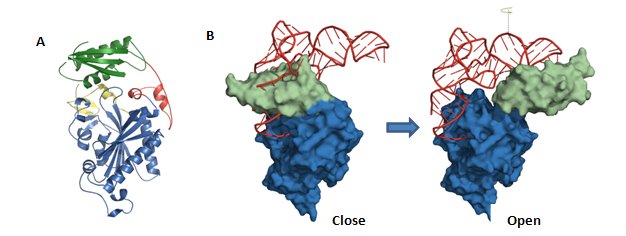We recently solved the structure, at 2.2Å resolution, of a human monomeric mitPheRS complexed with Phe-AMP (Figure 1A). Human mitochondrial phenylalanyl-tRNA synthetase (mitPheRS) is the smallest known nuclear encoded synthetase exhibiting homology to bacterial PheRSs. The mature mitPheRS homolog is a single-chain enzyme consisting of 415 amino acids, and in fact is a chimera of the bacterial catalytic subunit and the anticodon binding domain (ABD) from bacterial PheRS.

Figure 1. The structure of human mitPheRS. (A) Overall structure of the human mitPheRS enzyme. (B) Rotation of anticodon binding domain (ABD). The position of the tRNAPhe is obtained after superimposing the mitochondrial onto the bacterial catalytic domain (closed conformation). The ABD is colored pale-green, and the tRNA is colored red. This Figure demonstrates that a hinge-type movement (indicated by an arrow) of the mitPheRS ABD would be required to reach the anticodon of tRNAPhe (open conformation). |
Crosslinking the catalytic and RNA-binding domains resulted in a "closed" form of mitPheRS that still catalyzed ATP-dependent Phe activation, but was no longer able to transfer Phe to tRNA and complete the aminoacylation reaction. SAXS experiments indicated the presence of both the closed and open forms of mitPheRS in solution. Together, these results indicate that conformational flexibility of the two functional modules in mitPheRS is essential for its phenylalanylation activity.